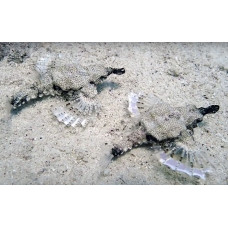Latin name
Eurypegasus draconis
Other name
Short dragonfish
Identification
The Latin word “draco” means a fabulous lizard-like animal. These fish have 19-22 vertebrae. Pelvic pelvic fin and 1st ray form an elongated structure resembling tentacles. They have 3 pairs of dorsolateral body plates; 4 pairs of ventrolateral body plates; 8 (rarely 9) movable tail rings. A pair of deep fossae posterior to the orbit. Suborbital shelf concave, eye visible when viewed from front. Abdominal ridges rostrum considerably wider than dorsal ridges, each with lateral denticles. Anal papilla absent.
Features of fish fins
Dorsal spines (total): 0; Dorsal soft rays (total): 5; Anal spines: 0; Anal soft rays: 5.
Fish colouring
Coloration varies throughout life; body usually light to dark brown, with dorsal and lateral parts darker than ventral surface. Pectoral fins hyaline, distal margin white with spots.
Distribution
Indo-Pacific: Red Sea and South Africa to the Marquesas and Society Islands, north to southern Japan, south to Australia and Lord Howe Island; all of Micronesia.
Habitat
A marine benthic species that prefers brackish water. Depth ranges from 3 to 91 m, usually 35 to 90 m.
Size
These small fish can grow up to 10 centimeters (3.9 inches) long.
Behavior
Swims in lagoons, often among thickets of algae or sea grass. Found on sandy or muddy bottoms, often in bays or estuaries.
Food and feeding habits
They are opportunistic feeders that collect mainly epifaunal and intra-tissue prey of invertebrates such as crustaceans and worms at the sediment-water interface. They periodically shed their skin intact and make rapid jumps to dispose of accumulated ballast. Adults usually live in pairs on muddy surfaces.
Reproduction
Has a monogamous mating system with the formation of close pairs. Are broadcast spawners. In some aquariums, spawning is observed when pairs rise about 50 cm above the surface of the substrate, their abdominal surfaces close together, releasing gametes at the apex of their upward movement; they then sink to the bottom. When the pairs land on the substrate, the male continues to follow his partner. Gametes are then released. Spawning occurs only in pairs (obligate and genetic monogamy).
Fishing
Have no commercial importance. Of no interest to fishermen.
Relationship with a person
Harmless. In China and Hong Kong, millions of these fish are sold each year for use in traditional medicine.
| Classification | |
| Phylum | Pegasidae |
| Class | Actinopterygii |
| Squad | Syngnathiformes |
| Genus | Eurypegasus |
| Species | E. draconis |
| Features | |
| Conservation status | Least Concern |
| Habitat | Pelagic |
| Life span, years | No information |
| Maximum body weight, kg | No information |
| Maximum length, cm | 10 |
| Sailing speed, m/s | No information |
| Threat to people | Not edible |
| Way of eating | Planktonophage |
Little dragonfish
Tags: little dragonfish



